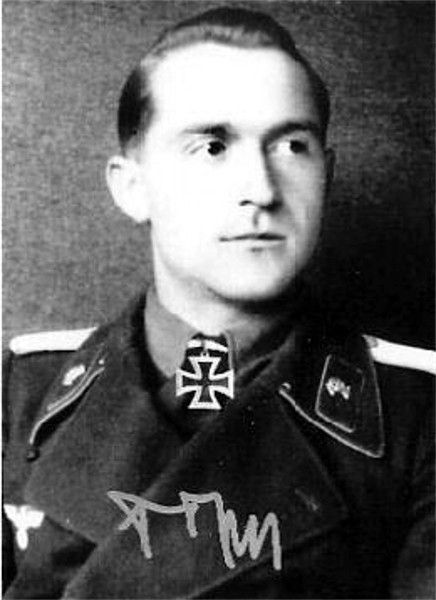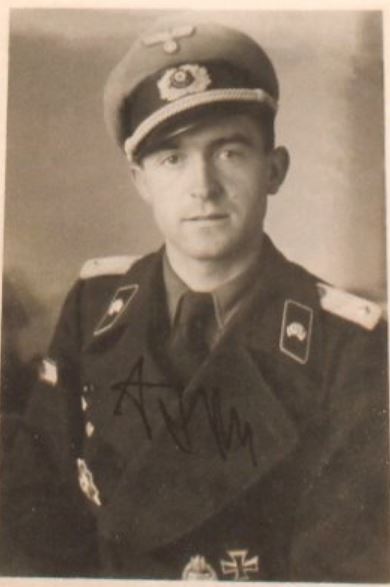Bayer, Franz
- Date of birth:
- February 3rd, 1920 (Langau/Lower-Austria, Austria)
- Date of death:
- April 28th, 2014 (Vienna/Lower Austria, Austria)
- Nationality:
- Austrian (1938-1945, Reichsgau)
Biography
Franz Bayer served with 6. / Panzer-Regiment 39, I. / Panzer-Regiment 26 and III. / Panzergrenadier-Regiment "Grossdeutschland".
Do you have more information about this person? Inform us!
- Period:
- Second World War (1939-1945)
- Unit:
- Zugführer, 6. Kompanie, Panzer-Regiment 39, 17. Panzer-Division
- Awarded on:
- October 1st, 1941
- Period:
- Second World War (1939-1945)
- Unit:
- Zugführer 6. / Panzer-Regiment 39
- Awarded on:
- October 20th, 1941
- Period:
- Second World War (1939-1945)
- Awarded on:
- January 10th, 1942
- Period:
- Second World War (1939-1945)
- Awarded on:
- August 18th, 1942
- Period:
- Second World War (1939-1945)
- Rank:
- Leutnant (2nd Lieutenant)
- Unit:
- Zugführer 6. / Panzer-Regiment 39
- Awarded on:
- October 7th, 1942
- Period:
- Second World War (1939-1945)
- Awarded on:
- 1942
- Period:
- Second World War (1939-1945)
- Awarded on:
- 1943
- Period:
- Second World War (1939-1945)
- Rank:
- Hauptmann (Captain)
- Unit:
- Führer, III. Abteilung, Panzer-Regiment "Großdeutschland"
- Awarded on:
- April 27th, 1944
- Period:
- Second World War (1939-1945)
- Rank:
- Hauptmann (Captain)
- Unit:
- Kommandeur, I. Abteilung, Panzer-Regiment 26, 26. Panzer-Division, Heer
- Awarded on:
- May 9th, 1945
“Recommendation for the award of the Knight’s Cross to the Iron Cross for Hauptmann Bayer. Submitted on the 31.12.1944 by the Panzer-Grenadier-Division Feldherrnhalle.
Hauptmann Bayer has been a well-known Kompanie commander for some time due to his calm, considerate, level-headed and bold leadership.
He was the Abteilung commander of the I./Panzer-Regiment 26 up until the 24.12.1944. In this capacity he achieved major successes during the time period 22.-24.12.1944 on the grounds of his prudent and determined leadership. With only 17 friendly Panzers he inflicted heavy losses on the Russians in this time period, destroying 73 tanks, 26 anti-tank guns and 17 trucks for the cost of only 1 of his own Panzers.
Particularly noteworthy were his actions on the 22.12.1944.
On this day Bayer received the order to capture the village of Pazmand from the north. He was to be supported by an SPW Kompanie of the Panzergrenadier-Regiment 4 and a Sturmhaubitz-Batterie. In a swift advance the Hills 155 and 152 (located south of Vereb) were captured, and the enemy lost 7 tanks and 9 anti-tank guns. 100 prisoners were also brought in. However a defensive front of anti-tank guns and dug-in tanks located northeast of Pazmand stopped any further advance beyond these hills. A withdrawal order was therefore issued by Oberst Schmidt, the commander of Panzer-Regiment 11.
However Bayer had identified significant hostile armour assemblies on both sides of Pazmand. Also, it was no longer possible to transmit messages to the Regiment as the radio had been smashed.
Bayer thus decided to hold the captured ground on his own initiative in order to intercept the Russian attack.
At around 10:30 the Russians launched their attack with about 40 tanks, partially enveloping the hills as they did so. 21 of the attacking tanks and 4 trucks with limbered anti-tank guns were destroyed.
Due to this independent resolve an enemy attack on Komarom was prevented, and they were thus unable to eliminate our own withdrawing troops (namely the 271. Volksgrenadier-Division as well as elements of the 6. Panzer-Division).”
Generalmajor Pape had the following additional comment concerning these actions…
“The recommendation is warmly endorsed.
Hauptmann Bayer proved to be a particularly bold officer while he was subordinated to Gruppe Pape. His successes in the time period 22.-24.12.1944 were possible due to the continual example he provided for his men through his personal bravery. By doggedly holding onto his newly won position it was possible for Gruppe Philipp (located southwest of Pazmand) to pull back from the enemy. The 271. Volksgrenadier-Division was also given time to set up a new defensive line further to the north along the line Vertes—Acsa—Val.”
According to research by Veit Scherzer, published in 2005 in his book “Die Ritterkreuzträger – Die Inhaber des Ritterkreuzes des Eisernen Kreuzes 1939 – 1945“, the awarding of the RK to Franz Bayer is questionable and not proven by primary sources.
Franz Bayer's nomination by the I./Panzer-Regiment 26 was written on 1-1-1945 and was approved by the III. Panzerkorps on 11-1-1945. The Division "Feldherrnhalle" had also submitted a nomination on 25-1-1945. Both nominations were sent to the 6th Army. Here they were left unattended, later consolidated, and approved by the commander-in-chief General Hermann Balck on 15-4-1945 and then forwarded to the Army Group. This nomination was received by the Heerespersonalamt (HPA—Army Staff Office) "Hauptbüro" (main office) on 28-4-1945, in this instance the 2nd squadron and not the 1st squadron. The Army Group South had made an error and wrongly addressed it to the HPA 2nd squadron. The Army Group, against regulation, had also not commented on the nomination and had explicitly mentioned this in the accompanying letter. The reason for this remains unknown. The entry date of 25-1-1945 which is noted on the file card is not the entry date but the date on which the Division "Feldherrnhalle" had created their nomination. The book "Verliehene Ritterkreuze" (Awarded Knight Crosses) does not list Bayer. No further proof that the presentation was made can be found in the archives. According to the Association of Knight's Cross Recipients (OdR) the award was presented in accordance with the Dönitz-decree. This is illegal according to the Deutsche Dienststelle (WASt) and lacks legal justification. Bayer himself stated on 10-2-2005 that the I./Panzer-Regiment 26 had "lent" him to the Division "Feldherrnhalle" where he was deployed as a company commander. He also stated that the battalion commander had presented him a Knight's Cross in January 1945 after he had received a radio message approving the nomination
Sources
- Photo 1: Willi Schumacher Collection
- Photo 2:
- - FEDERL, CH., Die Ritterkreuzträger der Deutschen Panzerdivisionen 1939-1945, VDM Heinz Nickel, Zweibrücken, 2000.
- FELLGIEBEL, W.P., Elite of theThird Reich, Helion & Company Limited, Solihull, 2003.
- PATZWALL, K. & SCHERZER, V., Das Deutsche Kreuz 1941-1945, Verlag Klaus D. Patzwall, Norderstedt, 2001.
- SCHERZER, V., Die Ritterkreuzträger 1939–1945, Scherzers Miltaer-Verlag, Jena, 2005.
- WEGMANN, GÜNTER, Die Ritterkreuzträger der Deutschen Wehrmacht 1939-1945, Biblio-Verlag, 2004.
- Ritterkreuztraeger 1939 - 1945
- Onderzoek via Panzer-Archiv Forum













